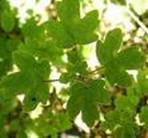| Kingdom | Plantae |
| Unranked | Angiosperms |
| Unranked | Eudicots |
| Order | Sapindales |
| Family | Sapindaceae |
| Genus | Acer |
| Species | A. campestre |
| Binomial name | Acer campestre |
Other Common Names:
The other common names for the maple tree are common maple, hedge maple and field maple.
History
The Maple (Acer campestre) is a representative of the genus Acer and of the order Sapindaceae.Field Maple wood was prized for carved work such as bowls. It appears very little in our history having been mainly used as a hedging tree.

Description
Maples are mostly trees growing to 10-40 metres (30-130 ft) in height. The branches of the Maple spread somewhat horizontally, and when growing apart from other trees it acquires a compact rounded head not unlike that of many Sycamores. The bark of the young branches is smooth, but early becomes brown, rough, and corky, splitting in longitudinal furrows, and affording a pleasing contrast to the crimson stalks of the young leaves, and to the somewhat somber greens of the foliage



Range
There are approximately 125 species with over 1000 cultivars of maple, mostly native to Asia, but several species also occur in Europe, northern Africa, and North America.
Habitat
Maple thrives on any well drained but moist soil, making it an ideal choice for virtually all gardens. It tolerates drought and air pollution. Usually found in swamps and uplands, it also occasionally grows on dry rocky hillsides and sand dunes.
Cultivation
Maple is a prolific seed producer and trees as young as four years may begin to bear seeds. Good seed crops are usually produced in alternate years. Seedbed requirements are minimal and up to 95% of viable seeds germinate in the first 10 days; some survive in the duff and germinate the following year. Because the mature seeds are dispersed in spring and can germinate immediately, seedlings can become established with a 3-4 month advantage over most associated woody species. A bank of persistent seedlings often accumulates beneath a forest canopy. Seedlings can survive 3-5 years of moderate shade, but establishment and early growth are best after disturbance. Male (staminate) trees may grow faster than female ones. Average longevity for red maple is about 80-100 years, but trees are known to reach 200 years of age. Vegetative reproduction under natural conditions is common from sprouts from the stump or root crown or root suckers after fire or mechanical damage. Buds located at the base of stems commonly sprout 2-6 weeks after the stem is cut.
Flowering Season
Maples flower in late winter or early spring, in most species with or just after the leaves appear, but in some before them. Maple flowers are green, yellow, orange or red.
Pests and Diseases
Besides being occasionally blotched in autumn by the attacks of the black fungus Rhytisma acerinum, so universal on the Sycamore, the leaves of the Maple are also commonly disfigured either by mildew or by a gall. The Maple blight or mildew (Uncinula bicornis) gives the whole plant a hoary appearance, as if sprinkled with powdered chalk, both surfaces of the leaves being alike affected; but this disease must not be confounded with an unhealthy condition formerly attributed to another fungus, and known as Erineum acerinum, which in spring produces patches of pinkish or violet hoariness on the under surfaces of the leaves, glistening like hoar-frost.
Parts Used


The inner bark, leaves, sap and seed of the maple tree are the most commonly used parts for its commercial and medicinal purposes.
Medicinal Applications


• The bark has astringent properties and has been used as an application for sore eyes.
• An infusion of the bark has been used to treat cramps and dysentery.
• Tea brewed from the inner bark has been used for treating coughs and diarrhea.
• A decoction of the leaves or bark opens obstructions of the liver and spleen and eases pains from them.
• Maple syrup is regarded as a 'health' food and is available from health stores. It can be used as a substitute for sugar.
Commercial Applications


• The wood of the maple is excellent as fuel, and can be made into charcoal.
• Probably best used as a hedging plant as it clips well.
• Maple syrup and its artificial imitations are the preferred toppings for pancakes, waffles, and French toast.
• The young shoots, being flexible and tough, are employed in France as whips.
• It is dried, ground into a powder and then used as a thickening in soups etc or mixed with cereals when making bread.
• The wood of the roots is often knotted and is valuable for small objects of cabinet-work.
• Maple syrup is sometimes boiled down further to make maple sugar, usually sold in pressed blocks, and translucent candy.

Passing a young child through the branches of this tree has traditionally thought to encourage good health and a long life for the child. A rather sad Swiss story is told about a number of dwarfs who used to sit on the branch of a Maple tree watching the haymaking. One night those with nothing better to do decide to cut through the branch making it dangerous to sit upon. When the dwarves next came to sit on the branch they fell to the floor. In order to avoid the eggs of the stork being disturbed by a bat or even being killed whilst still in their shells, according to Alsatian folklore; placing branches of the Maple would ensure protection against the bat. In fact planting a branch of the Maple tree in a house was said to ensure that bats will not dare to enter.